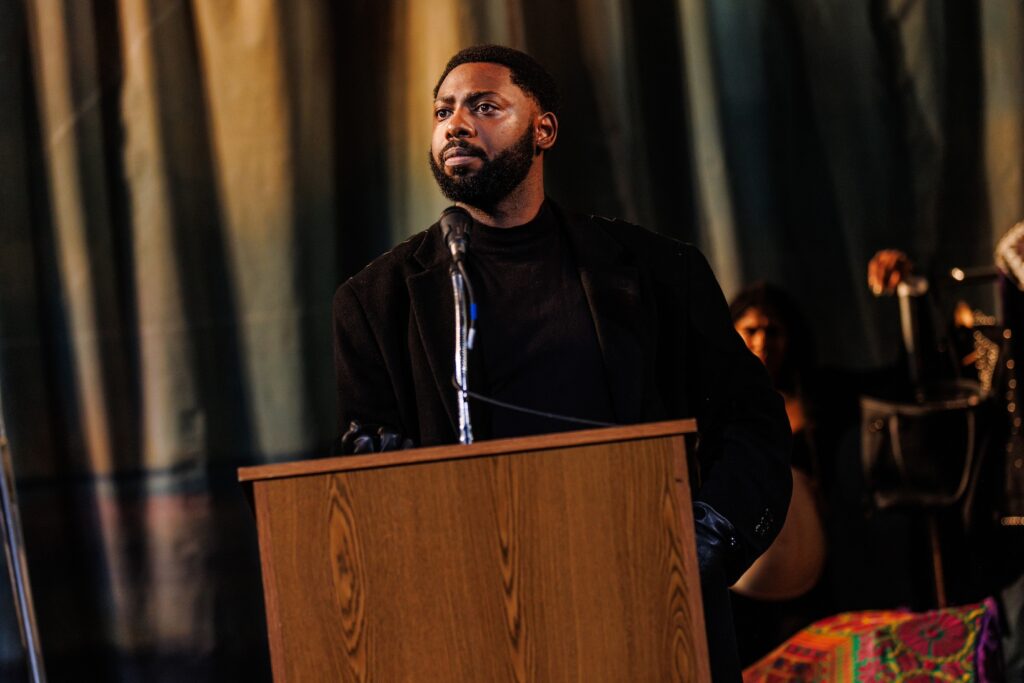With ‘Six Characters,’ Phillip Howze May Have Been Overambitious
In trying to tie together the many aspects of the play, this new ‘Six Characters’ can get a little busy and, despite its long-windedness, rather plain at times.

Much is obvious in Phillip Howze’s “Six Characters,” beginning with its title, a reference to Luigi Pirandello’s seminal metatheatrical work, “Six Characters in Search of an Author.” The dilemma in Mr. Howze’s play, mind you, might be more accurately described as one author in search of an editor.
For the uninitiated, Pirandello’s classic, first produced in Rome in 1921, opens with a rehearsal scene that is interrupted when the actors playing actors are confronted by other actors cast as characters who have been abandoned by their creator. What follows is an exploration of the dynamics between — and responsibilities of — playwrights and their collaborating artists, and their audiences, described by Pirandello in his preface as “a drama … which seeks at all costs to find the means of its own presentation; and a comedy of the vain attempt at an improvised realization of the drama on stage.”
Mr. Howze, a Yale School of Drama graduate and associate senior lecturer in Harvard’s Theater, Dance, and Media department, has added to all that a decidedly contemporary focus on identity, specifically race. In contrast to Pirandello’s play, his “Six Characters” features only that many characters, identified merely by number in the program; each further blurs the line between art and reality by assuming shifting and evolving roles.
The one constant, indicated in the script, is that all the players are required to be Black, like Mr. Howze. At first, this choice seems inspired by cultural archetypes: Character 2, for instance — described in the listings, which stress gender fluidity, as “female-identifying, or transwoman, or femme,” and played by a zesty Claudia Logan — quickly materializes as “Sassy,” a feisty, no-nonsense figure who laments, “Everybody’s afraid of taking direction from a strong Black woman.”

Sassy is speaking literally, as by this point she has taken the reins from the play-within-a-play’s actual director, a controlling but readily humiliated alpha male represented by Character 1 — portrayed here with a deft mix of authority and oafishness by Julian Robertson, who by the end of Act One will also be tasked with bellowing out a speech in an abrasive impersonation of Mussolini.
We also meet a long-suffering cleaning person, a slick but endearing police officer, and an aspirational youth who will try to conceal a sweet nature behind an air of street credibility, respectively played by Characters 3, 4, and 5. But it’s in introducing the last character that Mr. Howse distinguishes his mission: Described in the listings as “dark-skinned and gorgeous; fierce … could be female-identified, or any gender,” 6 is, it is soon revealed, an escaped slave.
Played by Seven F.B. Duncombe, who is indeed both gorgeous and fierce, and also brings a gentle gravitas and a playful wit to the part, 6 doesn’t dominate the narrative. Nor does the specific history Mr. Howse channels here — which is linked to Western imperialism, Black liberation, and enduring white nationalism — overshadow the themes and concerns that clearly drew him to Pirandello’s original text.
The problem is that in trying to tie it all together, this new “Six Characters” can get a little busy and, despite its long-windedness, rather plain at times. Under Dustin Wills’s generally nimble direction, the staging begins with Character 1 literally fumbling in the dark, then acquiring a pair of step ladders in an effort to grab something that remains just out of reach.
The glaring symbolism continues as more and more props are dragged onto the initially stark set, designed by Mr. Wills, among them a succession of fanciful costumes by Montana Levi Blanco. The top of Act Two finds 4 wearing an Elizabethan collar while 2 sports a strapped-on baby bump; both appendages come off as their conversation grows more intense and more rooted in their previous lives offstage.
The text, too, can poke and shout excessively — even when the actors don’t — or just gas on. Sometimes the bombast is purposeful, and even moving — or funny, as when 1 righteously reels off a list of victims of cancel culture, mentioning R. Kelly, J.K. Rowling, and Aristotle (who gets special attention in the play), as well as Christmas and, at the preview I attended, Lea Michele. (Ms. Michele isn’t acknowledged in the script, but here and elsewhere, Mr. Howze gives the performers license to ad-lib, and Mr. Robertson uses it with particular aplomb.)
In the end, despite Mr. Howze’s impressive ambition, and the considerable skill that he and the performers bring to the show, this “Six Characters” proves at once less than the sum of its parts and a bit too much.

